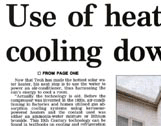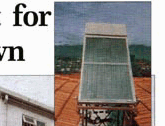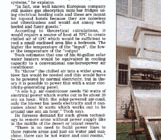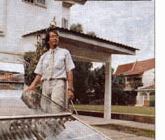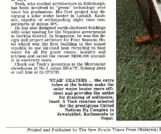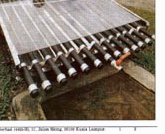|
'STAR' HEATERS...
the extra tubes
at the bottom make the solar water heater more efficient and provides the
outlet for draining of sediments. Inset: A Teoh creation selected for the
prestigious United Nations Hq Complex in Jawalakhel, Kathmandu in Nepal.
Now that Teoh has made the hottest solar water heater, his
next step is to use the water to power an air-conditioner, thus harnessing
the sun's energy to cool a room.
"Actually the technology is old. Before the compressor was invented in
the l920s, air-conditioning in factories and homes utilised gas absorption
cooling systems using kerosene powered heaters and the coolant used was
either an ammonia-water mixture or lithium bromide. This l9th Century technology
can be found in textbooks on cooling and refrigeration systems," he explains.
"In fact, one well known European company still makes gas absorption mini-bar
fridges using electrical heating coils and these are meant for top-end
hotels because they are noiseless and vibrationless and would not annoy
well-heeled and fussy guests."
According to theoretical calculations, it would require a source of heat
at 70 deg. to create chilled air of 15 deg. which would be sufficient to
cool a small enclosed area like a bedroom. The higher the temperature of
the "input", the lower the temperature of the "output".
Teoh estimates that one of his 60-gallon solar water heaters would be equivalent
in cooling capacity to a conventional one-horsepower air conditioner.
To "throw" the chilled air into a wider area, a blow fan would be needed
and this would have to be powered by normal electricity, but in theory
it is possible to power this with a solar electricity-generating panel.
"A one h.p. air conditioner needs 750 watts of electrical power which works
out to be about 20 sen an hour. With the solar-powered air-conditioner,
only the blower fan needs electricity and it consumes about 50 watts which
works out to be around one sen an hour," Teoh says.
He foresees demand for such green technology in remote areas without power
supply like in the middle of the desert or island resorts.
"There is no need to build power lines to these remote areas and just on
water and sunshine, there can be hot water and cool rooms," he says.
Teoh, who studied architecture in Edinburgh, has been involved in "green"
technology ever since his graduation. His first project was designing a
solar water heater in Ladakh, Kashmir, capable of withstanding night time
temperatures of minus 30 deg.
He has also designed earth-sheltered buildings with solar cooling for the
Nepalese government in Gorkha district. In Singapore, he was the design
and project architect for Four Seasons Hotel which was the first building
in the island republic to use air-conditioner heat recycling to heat water
for all the guest rooms, laundry and kitchen and saved the owner S$500,000
annually in electricity costs.
Check out Teoh's invention at the Microsolar showhouse at No 2, Jalan SS14/7F,
Subang Jaya or call him at 603-7373735.
|
